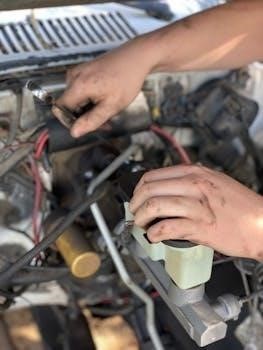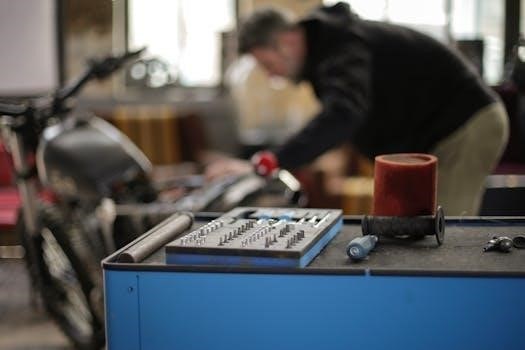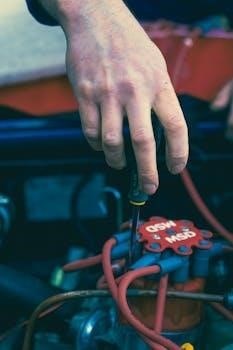Manuales de Taller para Motores Fuera de Borda Yamaha
Yamaha outboard workshop manuals are essential for proper maintenance and repair. These manuals‚ often in PDF format‚ provide detailed instructions for various models. They include specific information for both two-stroke and four-stroke engines‚ aiding owners and mechanics alike in keeping their motors in top condition.
Tipos de Manuales⁚ Dos Tiempos y Cuatro Tiempos
Yamaha outboard motors come in two primary engine types‚ each requiring specific workshop manuals⁚ two-stroke and four-stroke. Two-stroke manuals cover models known for their simplicity and higher power-to-weight ratio‚ often favored in older or smaller outboards. These manuals address the unique lubrication and combustion processes of two-stroke engines‚ detailing the necessary steps for maintenance and repair‚ including spark plug inspection‚ fuel system upkeep‚ and cylinder care. Conversely‚ four-stroke manuals delve into the more complex engineering of these engines‚ focusing on their efficient fuel consumption and lower emissions.
These manuals provide comprehensive guidance on valve adjustments‚ oil changes‚ timing belt/chain maintenance‚ and other intricate procedures specific to four-stroke technology. Having the correct manual—either for two-stroke or four-stroke—is vital for accurately troubleshooting‚ repairing‚ and maintaining your Yamaha outboard motor. This ensures the longevity and optimal performance of your marine engine‚ whether you’re a seasoned mechanic or a boat owner undertaking repairs yourself. The manuals are usually available in PDF format‚ making them easily accessible for download and reference.
Manuales de Usuario y Propietario
In addition to workshop manuals‚ Yamaha provides user and owner’s manuals‚ crucial documents for anyone operating their outboard motors. These manuals are designed for everyday users‚ offering guidance on safe operation‚ basic maintenance procedures‚ and troubleshooting common issues. Owner’s manuals often include vital information such as pre-operation checks‚ starting and stopping instructions‚ and recommended fuel and oil types. They also cover routine maintenance tasks like cleaning‚ checking fluid levels‚ and adjusting simple components. Furthermore‚ these manuals provide important safety guidelines and warnings to ensure the safe operation of the outboard motor‚ protecting both the operator and the equipment. Unlike workshop manuals‚ which are for detailed repairs‚ user and owner’s manuals focus on general use and preventive maintenance. These manuals are often included with the purchase of a new Yamaha outboard motor and are available for download in PDF format. They serve as a quick reference guide for daily use‚ ensuring owners are well-informed about their engine’s operation.

Componentes y Funcionamiento del Motor
Understanding the components and workings of a Yamaha outboard is crucial. Key elements like the cylinder‚ diameter‚ and stroke determine its performance. This section details the main parts‚ and their function‚ providing a foundation for maintenance and troubleshooting.

Conceptos Básicos⁚ Cilindro‚ Diámetro‚ Carrera
Understanding the fundamental concepts of an outboard engine is vital for effective maintenance and repair. The cylinder is the core component where combustion occurs‚ converting fuel into power. The cylinder’s diameter‚ often referred to as the bore‚ is the measurement across its circular opening. This dimension plays a key role in determining the engine’s displacement and overall power output.
The stroke‚ or carrera‚ refers to the distance the piston travels inside the cylinder from its highest point to its lowest point. Both the bore and stroke are critical in calculating the engine’s cubic capacity. When multiplied‚ these measurements determine the volume of space within the cylinder‚ thus influencing the engine’s performance characteristics.
These basic concepts are essential for understanding how an outboard engine works and are foundational when consulting a workshop manual. The cylinder‚ bore‚ and stroke are interrelated; alterations in any will affect the overall engine performance. Understanding these dimensions allows for precise adjustments and repairs‚ helping to maintain the engine’s efficiency and longevity. Referencing these basic concepts within the Yamaha workshop manual provides a clearer understanding of engine specifications and maintenance requirements.
Componentes Principales del Motor
A Yamaha outboard motor comprises several key components that work in harmony to generate power and propel a boat. The cylinder block‚ a crucial part‚ houses the cylinders where combustion occurs. Pistons move within these cylinders‚ converting pressure from combustion into mechanical motion through connecting rods linked to the crankshaft. The crankshaft then transforms this up-and-down motion into rotational energy‚ driving the propeller shaft.
The engine also features a cylinder head‚ which seals the top of the cylinder‚ and contains valves for intake and exhaust processes. The carburetor or fuel injection system is vital for supplying the proper air-fuel mixture to the cylinders. The cooling system‚ consisting of water jackets and an impeller‚ circulates water to regulate the engine’s temperature‚ preventing overheating. The ignition system‚ including spark plugs and coils‚ ignites the air-fuel mixture. The exhaust system allows for the safe expulsion of combustion gases.
These components work together‚ and their proper function is crucial for the engine’s reliability and performance. The workshop manual provides detailed diagrams and specifications for each component‚ assisting in maintenance and repairs. Understanding the function of each component is essential for diagnosing problems and ensuring the efficient operation of your Yamaha outboard motor. Regular inspection and care of these parts are vital for longevity.

Mantenimiento e Inspección Periódica
Regular maintenance and inspection are crucial for Yamaha outboard motor longevity. Key areas include checking spark plugs‚ fuel filters‚ propellers‚ impellers‚ and cooling channels. Additionally‚ gear oil and anodes should be inspected regularly to ensure optimal performance and prevent damage.

Inspección de Bujías y Filtros de Combustible
Regular inspection of spark plugs and fuel filters is vital for maintaining the optimal performance of your Yamaha outboard motor. Spark plugs play a critical role in igniting the fuel-air mixture‚ and their condition directly impacts engine efficiency and starting reliability. A fouled or worn spark plug can lead to misfires‚ reduced power‚ and increased fuel consumption. The inspection process involves checking for signs of wear‚ carbon deposits‚ or damage to the electrode. It’s essential to replace spark plugs according to the manufacturer’s recommendations‚ as outlined in your Yamaha workshop manual. This ensures consistent ignition and engine performance. Similarly‚ fuel filters are essential in preventing contaminants from reaching the engine’s carburetor or fuel injection system. Dirty or clogged fuel filters can restrict fuel flow‚ leading to engine hesitation‚ stalling‚ and potential damage to the fuel system components. Routine inspection of these filters helps identify when they need to be cleaned or replaced. The maintenance schedule provided in the workshop manual offers specific guidelines on the frequency of these inspections and the recommended replacement intervals. Using genuine Yamaha parts is crucial for maintaining optimal performance.
Mantenimiento de Hélices‚ Impulsores y Enfriamiento
Maintaining the propeller‚ impeller‚ and cooling system is crucial for the efficient and safe operation of your Yamaha outboard motor. The propeller is responsible for propelling the boat‚ and any damage or imbalance can lead to reduced speed‚ increased fuel consumption‚ and vibrations. Regular inspection includes checking for nicks‚ bends‚ or cracks in the propeller blades. It’s also vital to ensure the propeller is securely attached to the shaft and the cotter pin is in good condition. The impeller‚ part of the cooling system‚ is responsible for circulating water through the engine to prevent overheating; A damaged or worn impeller can lead to inadequate cooling‚ which can cause severe engine damage. Inspection should include checking for worn blades or any obstructions. Furthermore‚ the cooling system itself requires periodic maintenance. This involves ensuring that the water intake ports are free from debris and that the cooling passages are not clogged. Regular flushing of the cooling system is necessary to remove salt deposits or other contaminants that can hinder water flow. Following the maintenance guidelines provided in the Yamaha workshop manual is critical for preventing costly repairs and ensuring reliable performance.
Revisión del Aceite de Engranaje y Ánodos
Regular inspection and maintenance of the gear oil and anodes are vital for the longevity and optimal performance of your Yamaha outboard motor. The gear oil‚ which lubricates the gears in the lower unit‚ must be checked and changed periodically according to the manufacturer’s recommendations. Low or contaminated gear oil can lead to premature wear and failure of the gears. The inspection process involves checking the oil level and examining the oil for any signs of water contamination or metallic particles‚ which could indicate a leak or internal damage. The oil should be changed if it appears milky‚ discolored‚ or contaminated. Additionally‚ the anodes‚ often made of zinc or aluminum‚ are sacrificial parts designed to protect the metal components of the motor from corrosion. These anodes corrode instead of the more critical parts of the motor‚ so they must be inspected regularly and replaced when they are significantly eroded. Their condition directly impacts the motor’s overall protection from electrolysis. When inspecting the anodes‚ look for signs of wear and replace them before they become ineffective. Proper gear oil and anode maintenance‚ as described in the Yamaha workshop manual‚ are essential to prevent damage and ensure reliable performance of the outboard motor.
